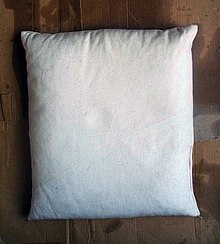Iron palm: Difference between revisions
m Bot: links syntax and minor changes |
remove advertising |
||
| Line 42: | Line 42: | ||
==External links== |
==External links== |
||
* [http://www.northern-dragons.co.uk Iron Fist (DVD)] ''' The ultimate in the Real Life Application of Iron Palm by Sifu Steven Burton - http://www.northern-dragons.co.uk [['''Iron Fist (Apple app)]] ''' the ultimate in Real Life Applicaton of Iron Palm by Sifu Steven Burton. [http://itunes.apple.com/gb/app/training-iron-fist/id421522571?mt=8 Click Here to get The ULTIMATE Iron Palm Iphone App] [IRON PALM TRAINING Iphone APP][http://itunes.apple.com/gb/app/training-iron-fist/id421522571?mt=8 Iron Fist or Iron Palm for any martial art] |
|||
*[http://www.youtube.com/watch?v=CPkGWNOlNA4#t=05m58s Iron Palm demonstration] |
*[http://www.youtube.com/watch?v=CPkGWNOlNA4#t=05m58s Iron Palm demonstration] |
||
Revision as of 14:48, 16 May 2011
This article needs additional citations for verification. (January 2008) |

| Part of a series on |
| Chinese martial arts (Wushu) |
|---|
 |
Iron Palm or Iron Hand (Chinese: 铁掌功) is a body of training techniques in various Chinese martial arts. These conditioning techniques are typically meant to condition the hands to allow a practitioner to deliver very powerful blows without injury to his or her hands.[1][2]
Overview
Iron Palm is a broad term covering many different conditioning methods. Some Iron Palm systems are considered internal and others are purely external in training methods. Martial artists who practice Iron Palm training are not unified in their training and techniques. Some teachers treat their Iron Palm methodology as a valuable secret, and only share their specific techniques, training methods, and herbal remedies with a select few.
Iron Palm is not a martial arts style unto itself, but a type of conditioning featured in many schools of Chinese martial arts. Some non-Chinese martial arts styles, such as Muay Thai and many schools of Karate, also feature hand conditioning; however, the term "Iron Palm" is not normally used to describe these types of training.
General Principles
Iron Palm training often involves three primary components:[3]
- Strengthening of the striking limbs by developing the tendons and ligaments from the shoulders to the fingertips, then striking or slapping relatively hard objects enclosed in canvas/leather bags. Following a conditioning session, the striking area is usually treated with a medicinal aid created from plant derivatives, usually a traditional Chinese liniment called Dit Da Jow.[4] A common belief among practitioners is that failing to apply Dit Da Jow after Iron Palm training sessions can have negative effects on long-term health, such as movement limitation, arthritis, and other nerve damage to the hands.
- Using proper technique to strike with greater force: As in other martial arts, students learn specific body mechanics with the intent to produce a more powerful strike. Students train to relax the body and release residual tension in order to move faster. This is usually done with standing meditation routines designed to release the residual tension in the body and develop "linking" power.
- Engaging in Qigong exercises in order to develop "qi" (also chi or ch'i, or Japanese ki). This Qigong training coordinates breathing to improve mental focus, resulting in a more powerful strike.
Direct and Indirect methods
Schools of Iron Palm training are often divided into "direct" or "indirect." Both methods usually consist of striking progressively harder surfaces. Some practitioners also refer to their training as Nei Jing ("internal") or Li ("external"), this deals with the Qi energy or type of force (jin) used. In the "direct" method the hands are thrust into buckets or containers of the medium; the hands come into direct-contact with the substance. In the "indirect" method, the practitioner strikes bags or other containers filled with various materials. As training progresses, the bags or buckets filled with increasingly resistant substances starting with sand or beans, progressing onto gravel or rocks, then finally steel shot. Practitioners can measure their progress based upon the number of strikes performed in a particular training session or by the amount of clock time spent training.
Uses
The Chinese Martial Arts can utilize a wide variety of open and closed hand strikes. Hardening the hands is also considered by some to supplement speed and strength lost through aging. Iron palm practitioners often demonstrate their abilities by breaking hard objects such as bricks, coconuts, stones and boards with their bare hands or in some cases hitting a steel object rapidly without sustaining injury. These demonstrations were often street performances used to make money for a martial artist or martial arts school.
See also
References
- ^ Lee, Ying-arng (2007). Iron Palm in 100 Days. Yamazato Pubns; collectors edition edition. ISBN 1424328888.
- ^ Chao, H.C. (1984). Complete Iron Palm Training for Self Defense. Unitrade Company; McLisa Enterprises distributor. ASIN B000F97K2M.
- ^ Wing, Lam (2002). Ultimate Iron Palm (first ed.). WLE Enterprises. ISBN 978-1586573539.
- ^ "Iron Palm Training". Coiling Dragon Internal Arts Association. Retrieved 2008-07-15. [dead link]
External links
- Iron Palm demonstration
- Iron Palm Training - Information about Iron Palm techniques, training, and theory
- Iron Palm Training - Videos show an internal iron palm method
